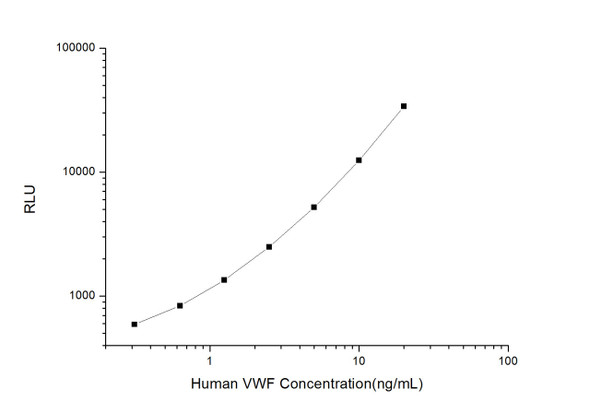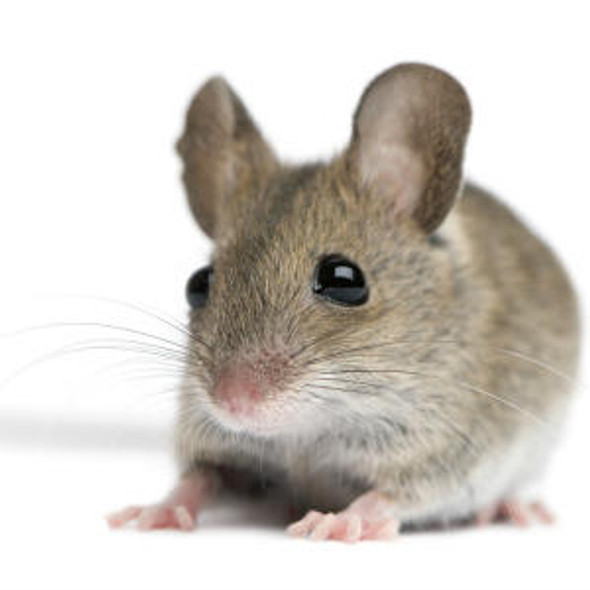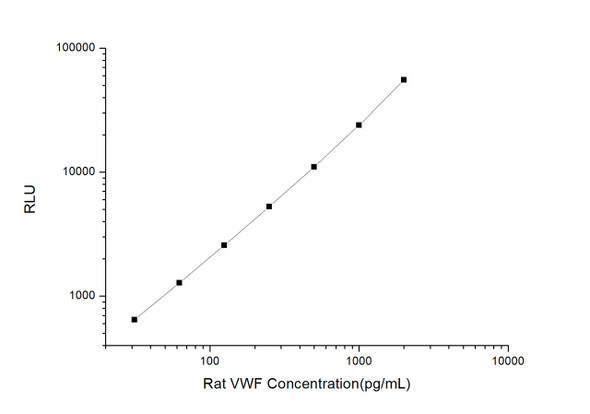Mouse Cardiovascular ELISA Kits
Mouse vWF (von Willebrand Factor) CLIA Kit (MOES00596)
- SKU:
- MOES00596
- Product Type:
- ELISA Kit
- ELISA Type:
- CLIA Kit
- Size:
- 96 Assays
- Sensitivity:
- 0.19ng/mL
- Range:
- 0.31-20ng/mL
- ELISA Type:
- Sandwich
- Synonyms:
- F8VWF, VWD
- Reactivity:
- Mouse
- Sample Type:
- Serum, plasma and other biological fluids
- Research Area:
- Cardiovascular
Description
| Assay type: | Sandwich |
| Format: | 96T |
| Assay time: | 4.5h |
| Reactivity: | Mouse |
| Detection method: | Chemiluminescence |
| Detection range: | 0.31-20 ng/mL |
| Sensitivity: | 0.19 ng/mL |
| Sample volume: | 100µL |
| Sample type: | Plasma |
| Repeatability: | CV < 15% |
| Specificity: | This kit recognizes Mouse vWF in samples. No significant cross-reactivity or interference between Mouse vWF and analogues was observed. |
This kit uses Sandwich-CLIA as the method. The micro CLIA plate provided in this kit has been pre-coated with an antibody specific to Mouse vWF. Standards or samples are added to the appropriate micro CLIA plate wells and combined with the specific antibody. Then a biotinylated detection antibody specific for Mouse vWF and Avidin-Horseradish Peroxidase (HRP) conjugate are added to each micro plate well successively and incubated. Free components are washed away. The substrate solution is added to each well. Only those wells that contain Mouse vWF, biotinylated detection antibody and Avidin-HRP conjugate will appear fluorescence. The Relative light unit (RLU) value is measured spectrophotometrically by the Chemiluminescence immunoassay analyzer. The RLU value is positively associated with the concentration of Mouse vWF. The concentration of Mouse vWF in the samples can be calculated by comparing the RLU of the samples to the standard curve.
| UniProt Protein Function: | VWF: Important in the maintenance of hemostasis, it promotes adhesion of platelets to the sites of vascular injury by forming a molecular bridge between sub-endothelial collagen matrix and platelet-surface receptor complex GPIb-IX-V. Also acts as a chaperone for coagulation factor VIII, delivering it to the site of injury, stabilizing its heterodimeric structure and protecting it from premature clearance from plasma. Defects in VWF are the cause of von Willebrand disease type 1 (VWD1). A common hemorrhagic disorder due to defects in von Willebrand factor protein and resulting in impaired platelet aggregation. Von Willebrand disease type 1 is characterized by partial quantitative deficiency of circulating von Willebrand factor, that is otherwise structurally and functionally normal. Clinical manifestations are mucocutaneous bleeding, such as epistaxis and menorrhagia, and prolonged bleeding after surgery or trauma. Defects in VWF are the cause of von Willebrand disease type 2 (VWD2). A hemorrhagic disorder due to defects in von Willebrand factor protein and resulting in impaired platelet aggregation. Von Willebrand disease type 2 is characterized by qualitative deficiency and functional anomalies of von Willebrand factor. It is divided in different subtypes including 2A, 2B, 2M and 2N (Normandy variant). The mutant VWF protein in types 2A, 2B and 2M are defective in their platelet- dependent function, whereas the mutant protein in type 2N is defective in its ability to bind factor VIII. Clinical manifestations are mucocutaneous bleeding, such as epistaxis and menorrhagia, and prolonged bleeding after surgery or trauma. Defects in VWF are the cause of von Willebrand disease type 3 (VWD3). A severe hemorrhagic disorder due to a total or near total absence of von Willebrand factor in the plasma and cellular compartments, also leading to a profound deficiency of plasmatic factor VIII. Bleeding usually starts in infancy and can include epistaxis, recurrent mucocutaneous bleeding, excessive bleeding after minor trauma, and hemarthroses. |
| UniProt Protein Details: | Protein type:Motility/polarity/chemotaxis; Secreted; Cell adhesion; Extracellular matrix; Secreted, signal peptide Cellular Component: extracellular matrix; proteinaceous extracellular matrix; endoplasmic reticulum; extracellular region; external side of plasma membrane Molecular Function:collagen binding; integrin binding; identical protein binding; protein binding; protein homodimerization activity; protease binding; chaperone binding; protein N-terminus binding; immunoglobulin binding; glycoprotein binding Biological Process: platelet activation; hemostasis; liver development; cell adhesion; blood coagulation; cell-substrate adhesion; protein homooligomerization; placenta development |
| UniProt Code: | Q8CIZ8 |
| NCBI GenInfo Identifier: | 86129842 |
| NCBI Gene ID: | 22371 |
| NCBI Accession: | |
| UniProt Related Accession: | Q2I0J7,Q2I0J8,Q3TD35,Q3TPE1,Q3U017,Q8CIZ8,Q9WUQ6 |
| Molecular Weight: | 309,102 Da |
| NCBI Full Name: | VWF |
| NCBI Synonym Full Names: | Von Willebrand factor homolog |
| NCBI Official Symbol: | Vwf |
| NCBI Official Synonym Symbols: | VWD; F8VWF; AI551257; C630030D09; 6820430P06Rik; B130011O06Rik |
| NCBI Protein Information: | von Willebrand factor; OTTMUSP00000025031 |
| UniProt Protein Name: | VWF |
| Protein Family: | von Willebrand factor |
| UniProt Gene Name: | Vwf |
| UniProt Entry Name: | Q2I0J7_MOUSE |
As the RLU values of the standard curve may vary according to the conditions of the actual assay performance (e. g. operator, pipetting technique, washing technique or temperature effects), the operator should establish a standard curve for each test. Typical standard curve and data is provided below for reference only.
| Concentration (ng/mL) | RLU | Average | Corrected |
| 20 | 33971 33993 | 33982 | 33950 |
| 10 | 11852 13088 | 12470 | 12438 |
| 5 | 5479 5021 | 5250 | 5218 |
| 2.5 | 2420 2628 | 2524 | 2492 |
| 1.25 | 1407 1359 | 1383 | 1351 |
| 0.63 | 891 843 | 867 | 835 |
| 0.31 | 616 630 | 623 | 591 |
| 0 | 31 33 | 32 | -- |
Precision
Intra-assay Precision (Precision within an assay): 3 samples with low, mid range and high level Mouse vWF were tested 20 times on one plate, respectively.
Inter-assay Precision (Precision between assays): 3 samples with low, mid range and high level Mouse vWF were tested on 3 different plates, 20 replicates in each plate.
| Intra-assay Precision | Inter-assay Precision | |||||
| Sample | 1 | 2 | 3 | 1 | 2 | 3 |
| n | 20 | 20 | 20 | 20 | 20 | 20 |
| Mean (ng/mL) | 0.96 | 2.29 | 9.10 | 0.94 | 2.27 | 9.14 |
| Standard deviation | 0.10 | 0.21 | 1.00 | 0.12 | 0.23 | 0.64 |
| C V (%) | 10.42 | 9.17 | 10.99 | 12.77 | 10.13 | 7.00 |
Recovery
The recovery of Mouse vWF spiked at three different levels in samples throughout the range of the assay was evaluated in various matrices.
| Sample Type | Range (%) | Average Recovery (%) |
| Serum (n=5) | 91-104 | 97 |
| EDTA plasma (n=5) | 88-100 | 94 |
| Cell culture media (n=5) | 86-99 | 93 |
Linearity
Samples were spiked with high concentrations of Mouse vWF and diluted with Reference Standard & Sample Diluent to produce samples with values within the range of the assay.
| Serum (n=5) | EDTA plasma (n=5) | Cell culture media (n=5) | ||
| 1:2 | Range (%) | 89-104 | 91-104 | 92-102 |
| Average (%) | 96 | 96 | 97 | |
| 1:4 | Range (%) | 93-107 | 90-101 | 92-105 |
| Average (%) | 100 | 96 | 98 | |
| 1:8 | Range (%) | 88-99 | 101-116 | 84-96 |
| Average (%) | 93 | 107 | 90 | |
| 1:16 | Range (%) | 88-102 | 94-107 | 89-103 |
| Average (%) | 94 | 99 | 94 |
An unopened kit can be stored at 4°C for 1 month. If the kit is not used within 1 month, store the items separately according to the following conditions once the kit is received.
| Item | Specifications | Storage |
| Micro CLIA Plate(Dismountable) | 8 wells ×12 strips | -20°C, 6 months |
| Reference Standard | 2 vials | |
| Concentrated Biotinylated Detection Ab (100×) | 1 vial, 120 µL | |
| Concentrated HRP Conjugate (100×) | 1 vial, 120 µL | -20°C(shading light), 6 months |
| Reference Standard & Sample Diluent | 1 vial, 20 mL | 4°C, 6 months |
| Biotinylated Detection Ab Diluent | 1 vial, 14 mL | |
| HRP Conjugate Diluent | 1 vial, 14 mL | |
| Concentrated Wash Buffer (25×) | 1 vial, 30 mL | |
| Substrate Reagent A | 1 vial, 5 mL | 4°C (shading light) |
| Substrate Reagent B | 1 vial, 5 mL | 4°C (shading light) |
| Plate Sealer | 5 pieces | |
| Product Description | 1 copy | |
| Certificate of Analysis | 1 copy |
- Set standard, test sample and control (zero) wells on the pre-coated plate and record theirpositions. It is recommended to measure each standard and sample in duplicate. Note: addall solutions to the bottom of the plate wells while avoiding contact with the well walls. Ensuresolutions do not foam when adding to the wells.
- Aliquot 100µl of standard solutions into the standard wells.
- Add 100µl of Sample / Standard dilution buffer into the control (zero) well.
- Add 100µl of properly diluted sample (serum, plasma, tissue homogenates and otherbiological fluids. ) into test sample wells.
- Cover the plate with the sealer provided in the kit and incubate for 90 min at 37°C.
- Aspirate the liquid from each well, do not wash. Immediately add 100µL of BiotinylatedDetection Ab working solution to each well. Cover the plate with a plate seal and gently mix. Incubate for 1 hour at 37°C.
- Aspirate or decant the solution from the plate and add 350µL of wash buffer to each welland incubate for 1-2 minutes at room temperature. Aspirate the solution from each well andclap the plate on absorbent filter paper to dry. Repeat this process 3 times. Note: a microplatewasher can be used in this step and other wash steps.
- Add 100µL of HRP Conjugate working solution to each well. Cover with a plate seal andincubate for 30 min at 37°C.
- Aspirate or decant the solution from each well. Repeat the wash process for five times asconducted in step 7.
- Add 100µL of Substrate mixture solution to each well. Cover with a new plate seal andincubate for no more than 5 min at 37°C. Protect the plate from light.
- Determine the RLU value of each well immediately.






